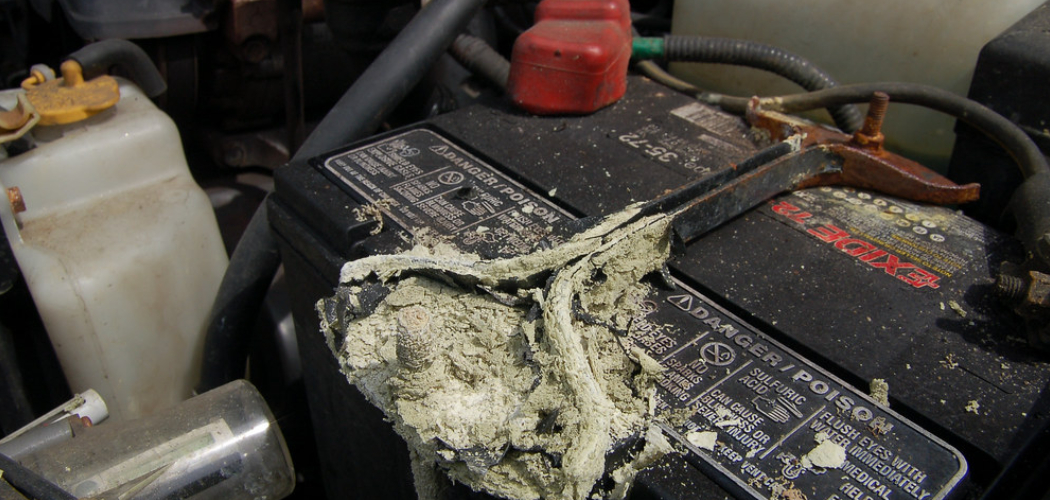A leaking car battery can be more than just a nuisance; it can be detrimental to your vehicle’s performance and can even pose significant safety risks. Corrosive acid leaks can damage the car’s metal components, leading to costly repairs while also creating a potential hazard for you and the environment.
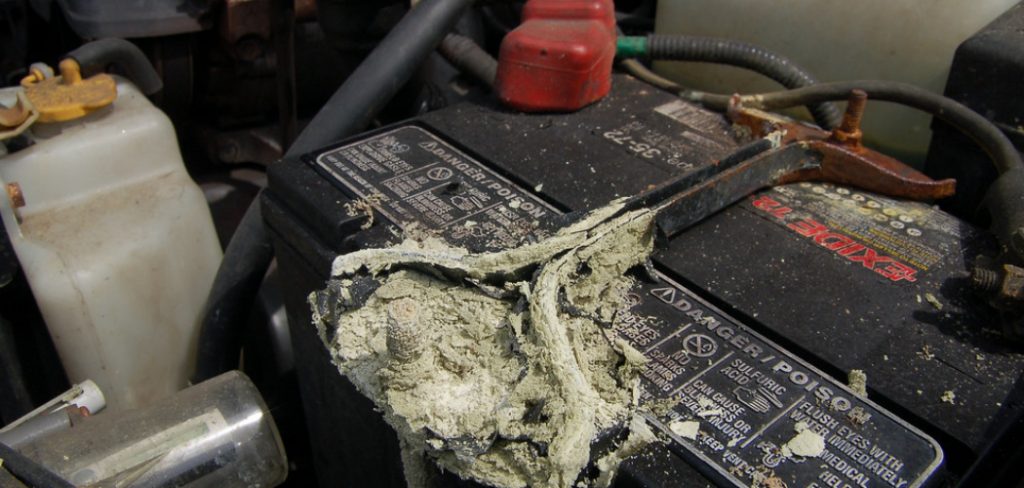
In this guide on how to fix a leaking car battery, we will walk you through the steps necessary to safely assess and fix a leaking car battery, ensuring that your vehicle continues to run smoothly and reliably. Remember, safety is paramount when dealing with car batteries, and it’s important to take the appropriate precautions throughout the process.
Why It is Important to Fix a Leaking Car Battery?
Fixing a leaking car battery is crucial for several reasons. Firstly, the acid from the battery can corrode and damage your car’s metal components, leading to costly repairs. Additionally, it can also cause electrical malfunctions in your vehicle, affecting its overall performance. Moreover, if left unaddressed, a leaking car battery can create a safety hazard.
The corrosive acid can cause burns and irritations to the skin, eyes, and respiratory system. Furthermore, it can also be harmful to the environment if not properly disposed of. It is essential to fix a leaking car battery promptly to avoid any potential damage and ensure the safety of yourself and others. It will also help maintain the longevity and efficiency of your vehicle.
How to Identify a Leaking Car Battery
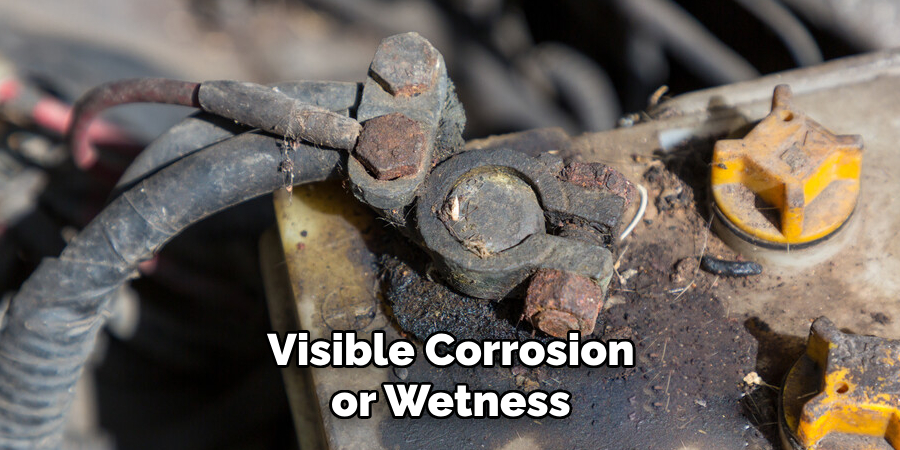
The most obvious sign of a leaking car battery is visible corrosion or wetness around the battery terminals. Other signs may include a foul smell, white powdery residue around the terminals, or difficulty starting the vehicle.
If you suspect a leak, it’s important to handle the battery with caution and avoid contact with the corrosive acid. You can also use a voltmeter to test the battery’s voltage and determine if it needs to be replaced.
Safety Precautions
When dealing with a leaking car battery, it’s crucial to take the necessary safety precautions. Make sure to wear protective gear such as gloves, safety glasses, and a mask to avoid any contact with the corrosive acid.
Keep children and pets away from the area and work in a well-ventilated space. It’s also recommended to disconnect the negative terminal of the battery before inspecting or fixing it.
Needed Tools and Materials
To fix a leaking car battery, you will need the following tools and materials:
Baking Soda Solution
A mixture of baking soda and water can neutralize the acid and make it safe to handle.
Clean Cloth or Brush
To clean off any corrosion from the battery terminals and surrounding areas.
Wrench or Pliers
To loosen and remove the battery terminals for inspection.
Battery Terminal Cleaner or Wire Brush
To remove any built-up corrosion on the terminals.
Epsom Salt Solution
A mixture of Epsom salt and water can help restore the battery’s electrolyte levels.
Distilled Water
To top up any lost fluid in the battery.
Things to Consider Before Start
1. Check for Warranty:
If your car battery is still under warranty, it’s best to take it to a professional or contact the manufacturer for assistance.
2. Age of the Battery:
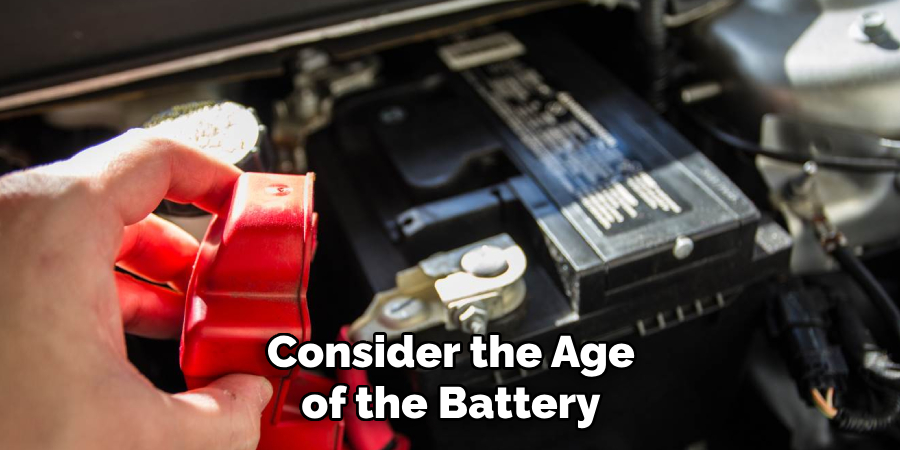
Consider the age of the battery before attempting to fix it. If it’s an older battery, it may be more cost-effective to replace it rather than trying to fix a leak.
3. Condition of the Battery:
Inspect the battery’s overall condition before attempting to fix a leak. If it is severely damaged, it may be safer to replace it rather than try to repair it.
10 Step-by-step Guidelines on How to Fix a Leaking Car Battery
Step 1: Prepare the Baking Soda Solution
Mix one cup of baking soda with a gallon of water in a plastic container. Stir until dissolved. Then, use a clean cloth or brush to apply the solution to the battery terminals and any areas affected by corrosion.
Let it sit for a few minutes before rinsing off with water. It’s important to wear gloves and safety glasses while handling the solution. You can also use a commercial battery cleaner product instead of the baking soda solution. That may be more effective in removing hardened corrosion.
Step 2: Disconnect the Battery
Using a wrench or pliers, loosen and remove the negative battery terminal first, followed by the positive terminal. Make sure to label or take a picture of the battery’s orientation before removing it for easier reinstallation. Otherwise, you may risk damaging other electrical components in the vehicle.
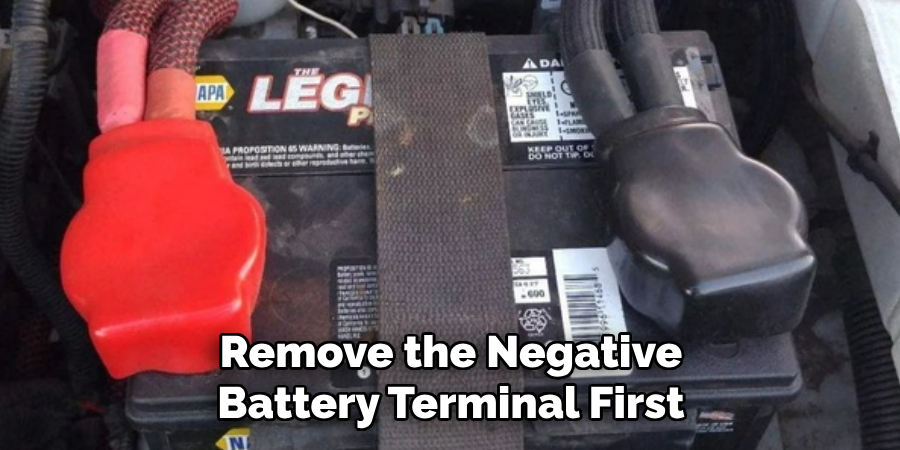
If the battery is difficult to remove, use a battery terminal puller tool. The purpose of disconnecting the battery is to isolate it from its electrical connections and avoid any potential hazards. It’s important to clean the terminals before reconnecting them.
Step 3: Inspect the Battery
Carefully inspect the battery for any cracks or holes that may be causing the leak. If you find any, the battery will need to be replaced entirely. Also, check for any loose or damaged parts that may have caused the leak. You can also use a voltmeter to test the battery’s voltage and determine if it needs to be replaced.
It’s recommended to replace a battery if it has less than 12 volts of charge. The average lifespan of a car battery is 3-5 years. The battery’s age can also be a factor in determining if it needs to be replaced. You can usually find the date of manufacture on the battery’s casing.
Step 4: Clean the Battery
Using a clean cloth or brush, wipe off any remaining corrosion or residue on the battery terminals and surrounding area. Make sure to dispose of the cloth or brush properly afterward, as it may contain corrosive acid. Otherwise, it can cause further damage if left unattended. If you have a wire brush, use it to clean off any hardened corrosion on the terminals.
However, you can also use a battery terminal cleaner product for more effective results. But make sure to follow the instructions and safety precautions on the product label. It’s important to have a clean surface before attempting to fix or reinstall the battery.
Step 5: Prepare the Epsom Salt Solution
Mix one cup of Epsom salt with a gallon of distilled water in a plastic container. Stir until dissolved. Then, carefully pour the solution into each battery cell until they are all equally filled. The Epsom salt solution can help restore the electrolyte levels and improve the battery’s overall performance.
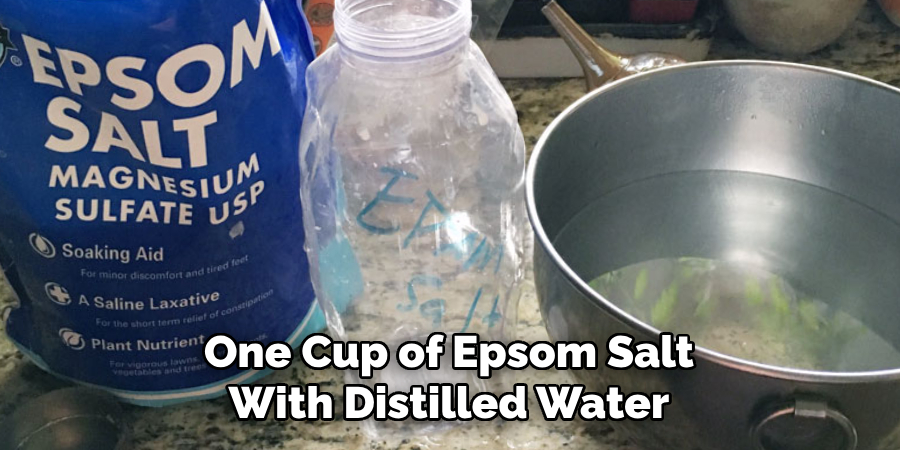
It’s important to only use distilled water in the battery cells, as tap water may contain minerals or impurities that can damage the battery. You can also use a funnel to make it easier and less messy.
Step 6: Reconnect the Battery
Clean and dry off the battery terminals before reconnecting them. Make sure to reconnect the positive terminal first, followed by the negative terminal. Use a wrench or pliers to tighten the connections securely. Avoid over-tightening, as it can damage the terminals.
You can also apply a small amount of petroleum jelly or dielectric grease onto the terminals to prevent future corrosion. But make sure not to get any on the battery itself. This step is essential to ensure proper electrical connections and avoid any potential hazards.
Step 7: Clean Up
Dispose of any used materials, such as the baking soda solution and Epsom salt solution, properly. Rinse off any spills or residue with water and dry the area thoroughly. Make sure to remove your gloves, safety glasses, and mask before handling any other objects.
Wash your hands properly with soap and water to avoid any contact with corrosive acid. Remember to always handle a leaking car battery with caution and care. It’s also recommended to dispose of the old battery at a recycling center.
Step 8: Restart the Vehicle
After completing all the steps above, start your vehicle’s engine to see if the battery is functioning properly. If it fails to start, you may need to charge the battery or have it tested at a mechanic shop. It’s also important to keep an eye on the battery and monitor its performance for any signs of further leaks or issues.
In case of any recurrence, it’s recommended that you seek professional help. Make sure to keep the area around the battery clean and free of any debris or spills. Otherwise, it can cause damage to the battery and other electrical components.
Step 9: Regular Maintenance
To prevent future leaks, it’s essential to maintain your car battery regularly. This includes checking for corrosion, cleaning the terminals, and topping up fluid levels with distilled water if necessary. It’s also recommended to have a mechanic inspect your battery and electrical system during routine maintenance appointments.
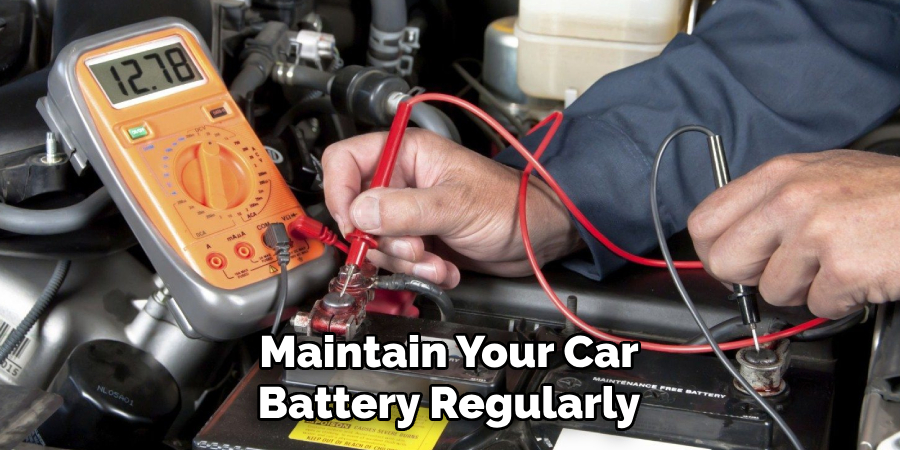
They can detect any potential issues and address them before they become major problems. It’s better to be proactive and prevent leaks rather than dealing with them after they occur.
Step 10: Replacing the Battery
If your battery continues to leak despite all efforts, it may be time for a replacement. Make sure to choose a high-quality battery from a reputable brand that is compatible with your vehicle’s make and model. It’s also recommended to have a professional mechanic install the battery for proper and safe installation.
They can also dispose of the old battery properly, as it contains hazardous materials. Remember to always handle car batteries with caution and care to avoid any accidents or damage.
Following these steps on how to fix a leaking car battery and maintain your car battery properly can help prevent leaks and ensure reliable performance. However, if you encounter any issues or are unsure about how to handle a leaking battery, it’s always best to seek professional assistance.
They have the knowledge, experience, and proper equipment to safely address any problems with your car battery. Don’t wait until it’s too late – take care of your battery regularly to avoid any inconveniences or hazards on the road. So, make sure to inspect and maintain your car battery frequently for a longer lifespan.
Advanced Battery Leak Repair Techniques
In addition to the steps outlined above, there are also more advanced battery leak repair techniques available. These methods should only be attempted by individuals with proper training and experience in car maintenance and repairs.
Battery Acid Neutralization
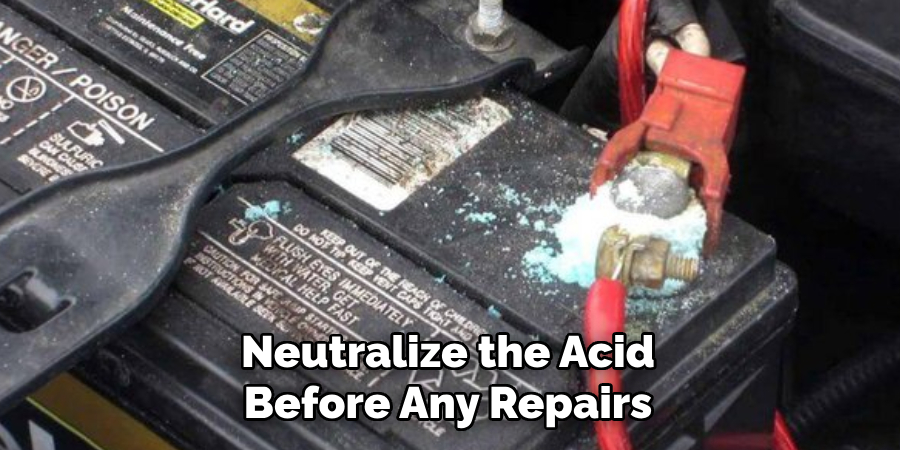
If you encounter a leaking car battery with significant corrosion buildup, it’s important to neutralize the acid before attempting any repairs. This can be done by using a neutralizing agent, such as baking soda or lime juice, and carefully applying it to the affected areas. Make sure to wear protective gear and work in a well-ventilated area when doing this. After neutralization, thoroughly clean and dry the battery before proceeding with repairs.
Battery Reconditioning
Another method for repairing a leaking car battery is through reconditioning. This involves using specialized equipment to rejuvenate the battery and restore its performance. However, this technique can be expensive and may not always be successful. It’s best to consult with a professional mechanic before attempting this method.
Sealing Leaks
In some cases, it may be possible to seal small leaks in a car battery using specialized products, such as epoxy or silicone sealant. However, this is not a permanent solution and may only provide temporary relief. It’s important to still address the underlying issue causing the leak and consider replacing the battery if necessary.
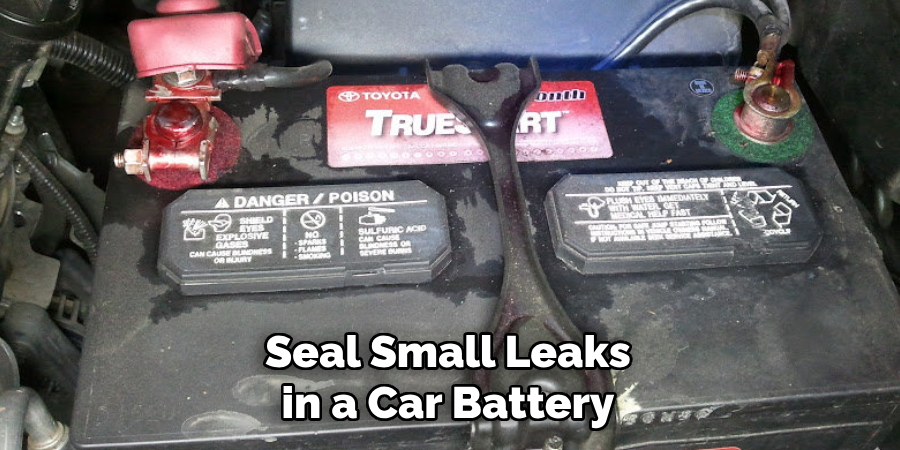
Overall, it’s essential to handle a leaking car battery with caution and care and seek professional help if needed. Keeping up with regular maintenance and inspections can also prevent leaks and ensure safe and reliable performance from your car battery. So, make sure to take proper care of your car battery for a smooth driving experience. Happy driving!
Common Car Battery Leak Repair Challenges and Solutions
Corrosion Buildup:
As mentioned earlier, corrosion buildup can be a challenge when repairing a leaking car battery. Using a neutralizing agent and thoroughly cleaning the affected areas can help address this issue.
Difficult Access to Battery Terminals:
In some cases, it may be challenging to access the battery terminals for repairs. This can be solved by using specialized tools, such as a battery terminal puller or brush, to remove and clean the terminals safely.
Deeper Battery Damage:
If a car battery has been leaking for an extended period, it can cause internal damage that may not be visible. In these cases, it’s best to have a professional mechanic inspect and assess the extent of the damage before attempting any repairs or replacements.
Incompatible Battery:
Using a battery that is not compatible with your vehicle’s make and model can also lead to leaks. Always double-check the specifications before purchasing a new battery and seek professional advice if unsure.
Frequently Asked Questions
Q: Can I Use Tap Water Instead of Distilled Water for the Epsom Salt Solution?
A: It’s not recommended to use tap water as it may contain minerals or impurities that can damage the battery. Distilled water is free of these contaminants and is safer to use in your car battery.
Q: How Often Should I Check and Maintain My Car Battery?
A: It’s recommended to check your car battery monthly and perform maintenance as needed, such as cleaning the terminals and topping up fluid levels. You should also have a professional inspect the battery and electrical system during routine maintenance appointments.
Q: Can I Replace My Car Battery Myself?
A: While it is possible to replace a car battery yourself, it’s recommended to have a professional handle it for proper and safe installation. They can also dispose of the old battery properly, as it contains hazardous materials.
Q: How Do I Dispose of an Old Car Battery?
A: It’s important to dispose of an old car battery at a recycling center or return it to a battery retailer. Do not throw it in the trash as it contains hazardous materials.
Q: What Are Some Signs of a Leaking Car Battery?
A: Some signs of a leaking car battery include corrosion on the terminals, a strong sulfur smell, and low levels of electrolyte fluid. If you notice any of these signs, it’s important to address the issue promptly to prevent further damage.
Conclusion
In conclusion, promptly addressing a leaking car battery is crucial for maintaining your vehicle’s performance and your own safety. By following the steps outlined in this guide on how to fix a leaking car battery, you can effectively identify the source of the leak and execute the necessary repairs or replacements.
Remember to always prioritize safety by wearing protective gear and working in a well-ventilated area. If at any point you feel uncertain about handling battery acid or performing repairs, do not hesitate to consult with a professional mechanic. Taking action against leaks can save you from more severe issues down the line and keep your vehicle running efficiently.

